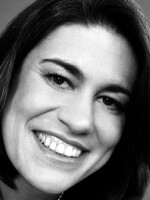MELISSA BLOCK, host:
There are more than 100 million high-definition televisions in the United States now, and that's bad news for your favorite TV stars. HD defines every last sag and crinkle and makes it way easier to see tightening around the lips, a hallmark of plastic surgery.
NPR's Laura Sydell reports that this new technology is keeping old-fashioned cinematographers and makeup artists very busy.
LAURA SYDELL: Sports looks so great in HD. The grass looks greener, the numbers on the uniforms are clearer, and you can see the muscles in the shortstop's arm as he reaches up to catch a fly ball. The athletes don't care if you can also see the sweat on their grimy faces, but…
Mr. DON MORGAN (Cinematographer): Actors do not like it.
SYDELL: Don Morgan has been a Hollywood cinematographer for over 20 years. In an industry which trades beauty for dollars, part of Morgan's job is taking some of the definition out of high definition.
Mr. MORGAN: I take all the detail out of these $400,000 cameras.
SYDELL: Morgan says most of these cameras have settings that enable him to adjust how the camera picks up skin tones.
Mr. MORGAN: I smooth them out so you don't see the flaws as much, and then add a little bit of different types of filters to smooth out the picture.
SYDELL: Morgan says he also uses dimmer lighting on close-ups. He doesn't focus in as sharply as he could. He did the cinematography for the UPN show "Girlfriends."
(Soundbite of television program, "Girlfriends")
Unidentified Woman #1 (Actress): (As character) Oh, I slept with a married man on and off for six months, and he happens to be friends with Aaron, and we're supposed to have dinner with him and his wife Saturday. Help.
(Soundbite of laughter)
SYDELL: One of the show's four women leads - Morgan won't name names - felt Morgan wasn't doing enough to make her look good.
Mr. MORGAN: We got into it a couple of times and stopped projects because she said that I'm not paying attention enough to her.
SYDELL: Keeping the actors beautiful got a lot harder for makeup artist Eryn Krueger the first time she did HD.
Ms. ERYN KRUEGER (Makeup Artist): And there was a lot of issues with making sure that reds weren't flaring. Like a lot of times, red lipsticks really will flare on camera, making sure that there's not a lot of see-through spots with hair, like, making sure that everything is very together.
SYDELL: Krueger says entirely new lines of makeup have been developed especially for HD. She also airbrushes the makeup on to avoid finger marks. Eryn Krueger does makeup for "Nip/Tuck."
(Soundbite of song, "Make Me Beautiful")
Unidentified Woman #2 (Singer): (Singing) Make me beautiful.
SYDELL: The cast of this show, about a plastic-surgery practice, was singing its own theme song to Krueger, "Make Me Beautiful," when they did a special episode shot in HD. The show has a cast that's mostly over the age of 35, so she had to keep a watchful eye on what was coming through the camera lens.
Ms. KRUEGER: I'm a little bit more cautious and spend more time looking at the monitor and adjusting, and all day adjusting and making sure that everything looks good.
SYDELL: In the entertainment glamour biz, making actors look younger isn't new. Over the last century, moving-picture technology keeps getting better at depicting the details of reality. With each new advance, the people behind the camera have got to figure out how to cover up the bits of reality that aren't pretty.
(Soundbite of TV program, "The Loretta Young Show")
Ms. LORETTA YOUNG (Actress): (As Inga Helborg) Hello. Have you ever noticed how quickly we can discern ridiculousness in the behavior of others?
SYDELL: "The Loretta Young Show," which aired in the 1950s, is responsible for an entirely new camera technique, according to Don Tillman, a professor at USC's School of Cinematic Studies. Young had been a popular actress in the 1930s and '40s. By the time she did her show, she was older.
Professor DON TILLMAN (School of Cinematic Studies, University of Southern California): So somebody came up with a thing called gauze across the camera lens. It was a very thin piece of gauze. She looked probably 20 years younger because you didn't see the blemishes. You didn't see the lines on her face and so on and so forth.
SYDELL: Now, 3-D is being touted as the next entertainment technology, which raises a question: What do wrinkles look like in 3-D?
Laura Sydell, NPR News. Transcript provided by NPR, Copyright NPR.



